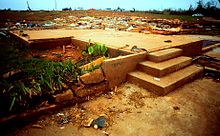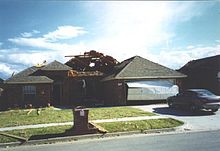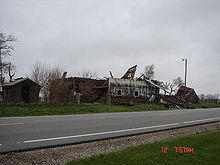Fujita scale
The Fujita scale (F-Scale), or Fujita-Pearson scale, rates a tornado's intensity by the damage it inflicts on human-built structures and sometimes on vegetation. The rating is of the most severe damage to any well-built frame home or comparable level of damage from engineering analysis of other damage. Fujita scale ratings are issued after a tornado has passed through an area, not while it is on the ground. The official Fujita scale category is determined after meteorologists (and engineers) examine damage, ground-swirl patterns, radar tracking, eyewitness testimonies, media reports and damage imagery, and sometimes photogrammetry/videogrammetry.
Educated guesses at wind speed ranges were made based on the damage seen, but the original numbers have since been found to be higher than the actual wind speeds required to incur the damage described at each category. The error manifests itself to an increasing degree as the category increases, especially in the range of F3 through F5. The wind speeds listed should not be taken literally—the National Oceanic and Atmospheric Administration notes that …precise wind speed numbers are actually guesses and have never been scientifically verified. Different wind speeds may cause similar-looking damage from place to place—even from building to building. Without a thorough engineering analysis of tornado damage in any event, the actual wind speeds needed to cause that damage are unknown.[1]
Beginning on February 1, 2007, the Fujita scale will be updated to the Enhanced F Scale (EF Scale) for operational use in the United States. The Enhanced F Scale accounts for different degrees of damage that occur with different types of structures, as well as damage to things other than structures.
The scale was introduced in 1971 by Tetsuya "Ted" Fujita of the University of Chicago who developed the scale together with Allen Pearson (path length and width additions in 1973), head of the National Severe Storms Forecast Center (predecessor to the Storm Prediction Center) in Kansas City, Missouri.
Current Fujita scale
Derivation

The gap between F0 and F1 corresponds to the eleventh and twelfth levels of the Beaufort scale, "violent storm" and "hurricane" respectively. Theoretically, the wind speeds for F11 and F12 correspond to Mach numbers 0.9 and 1.0 respectively. This provides a smooth relationship between the three scales. From these wind speed numbers, qualitative descriptions of damage were made for each category of the Fujita scale, and then these descriptions are used to classify tornadoes.[2]
The diagram on the left illustrates the relationship between the Beaufort, Fujita, and Mach number scales.
Parameters
The six categories are, in order of increasing intensity (F6 is not in use):
| Category F0 | Wind speed | Less than 73 mph | Less than 116 km/h | Relative frequency | 38.9% |
| Potential damage |  | ||||
| Category F1 | Wind speed | 73–112 mph | 116–180 km/h | Relative frequency | 35.6% |
| Potential damage |  | ||||
| Category F2 | Wind speed | 113–157 mph | 181–250 km/h | Relative frequency | 19.4% |
| Potential damage |  | ||||
| Category F3 | Wind speed | 158–206 mph | 251–330 km/h | Relative frequency | 4.9% |
| Potential damage |  | ||||
| Category F4 | Wind speed | 207–260 mph | 331–415 km/h | Relative frequency | 1.1% |
| Potential damage |  | ||||
| Category F5 | Wind speed | 261–318 mph | 416–510 km/h | Relative frequency | Less than 0.1% |
| Potential damage |  | ||||
| Category F6 | Wind speed | 319–379 mph | 511–609 km/h | Relative frequency | never observed |
| Potential damage | Inconceivable damage. These winds are very unlikely. The small area of damage they might produce would probably not be recognizable along with the mess produced by F4 and F5 wind that would surround the F6 winds. Missiles, such as cars and refrigerators would do serious secondary damage that could not be directly identified as F6 damage. If this level is ever achieved, evidence for it might only be found in some manner of ground swirl pattern, for it may never be identifiable through engineering studies. Most scales do not include F6. | ||||
(*) This table presents the relative frequency of tornadoes in the United States. Frequencies of strong tornadoes (F2 or greater) are significantly less elsewhere in the world. Canada, Bangladesh and adjacent areas of eastern India also have frequent severe tornadoes, however statistics in these countries have not been studied thoroughly.
The Enhanced F-Scale (EF Scale)
The list below is the Enhanced Fujita Tornado Scale (EF Scale) to take effect February 1, 2007. The scale was revised to reflect better examinations of tornado damage surveys so as to align wind speeds more closely with associated storm damage. The new scale was publicly unveiled at a conference by the American Meteorological Society in Atlanta on February 2, 2006.
The new scale has to do with how most structures are designed. The wind speeds on the original scale were deemed by meteorologists as being too large and engineering studies have shown that slower winds can cause the same damage as that of winds of 300 mph. The new scale lists an EF-5 as a tornado with winds at or above 200 mph (324 km/h) – which corresponds to the wind speeds of F3 or F4 in the original Fujita scale. None of the tornadoes recorded before January 31, 2007 will be re-categorized.
Essentially, there is no functional difference in how tornadoes are rated. The old ratings and new ratings are cleanly connected with a linear formula. The only differences are adjusted wind speeds, measurements of which weren't used in previous ratings, and refined damage descriptors.
Parameters
The six categories for the EF Scale are, in order of increasing intensity:
| Category EF0 | Wind speed | 65-85 mph | 105-125 km/h | |
|---|---|---|---|---|
| Potential damage |  Peels surface off roofs; some damage to chimneys; branches broken off trees; shallow-rooted trees pushed over; mobile homes pushed off foundations or overturned; sign boards damaged. | |||
| Category EF1 | Wind speed | 86-110 mph | 126-179 km/h | |
| Potential damage |  Roofs torn off frame houses; windows and glass doors broken; moving autos blown off roads; mobile homes demolished; boxcars overturned. | |||
| Category EF2 | Wind speed | 111-135 mph | 180-227 km/h | |
| Potential damage |  Roofs torn off well-constructed houses; foundations of frame homes shifted; large trees snapped or uprooted; light-object missiles generated; cars lifted off ground. | |||
| Category EF3 | Wind speed | 136-165 mph | 228-308 km/h | |
| Potential damage |  Some walls torn off well-constructed houses; trains overturned; most trees in forest uprooted; heavy cars lifted off the ground and thrown; structures with weak foundations blown away some distance. | |||
| Category EF4 | Wind speed | 166-200 mph | 309-324 km/h | |
| Potential damage |  Well-constructed houses and whole frame houses completely leveled; structures with weak foundations blown away some distance; trees debarked; cars thrown and small missiles generated. | |||
| Category EF5 | Wind speed | >200 mph | >324 km/h | |
| Potential damage |  Strong frame houses leveled off foundations and swept away; with strongest winds, brick houses completely wiped off foundations; automobile-sized missiles fly through the air in excess of 100 m (109 yd); cars thrown and large missiles generated; incredible phenomena will occur. | |||
Differences in the new scale
Twenty-eight Damage Indicators (DI) will be used in the new system with Degrees of Damage (DOD) to determine wind estimates. Different buildings depending on building material will have their own DIs and DODs.
Since the new system will still use actual tornado damage to estimate the storm's wind speed, the National Weather Service states that the new scale will likely not lead to an increase in a number of tornadoes classified as EF5 (the lower wind speed ranges have been adjusted as better estimates of what is needed to incur the damage). The upper bound of the wind speed range for EF5 is open — in other words, there is no maximum wind speed designated.
See also
- Beaufort scale
- TORRO scale
- Saffir-Simpson Hurricane Scale
- List of tornadoes and tornado outbreaks
- List of F5 tornadoes
- Severe weather terminology
References
External links
- NOAA National Weather Service Improves Tornado Rating System (NOAA News)
- Enhanced F Scale for Tornado Damage (NOAA / SPC)
- The Enhanced Fujita Scale (EF Scale) {NOAA / SPC)
- Fujita Scale Enhancement Project (Wind Science Engineering & Research Center at Texas Tech University)
- Mitigation Assessment Team Report: Midwest Tornadoes of May 3, 1999 (FEMA)
- A Guide to F-Scale Damage Assessment (NWS)
- A Guide for Conducting Convective Windstorm Surveys (NWS SR146)
- The Tornado: An Engineering-Oriented Perspective (NWS SR147)
